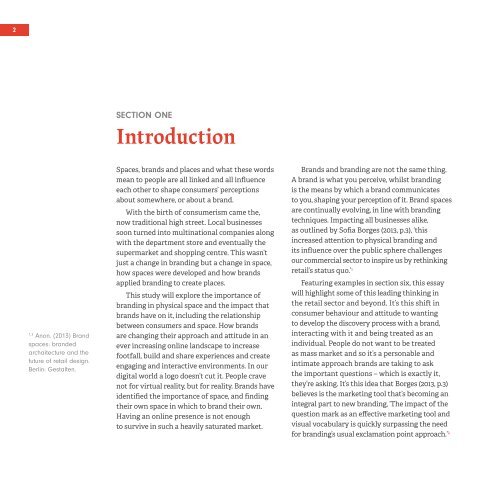Brand—Space
The impact of branding on physical space and the importance of creating an experience. Branded space, in the form of shops, museums, cafés and restaurants have an effect on us everyday. This study will look at the impact of physical space – how it can influence us and how it shapes our perceptions of brands and places. Including case studies from around the world and interviews with industry professionals.
The impact of branding on physical space and the importance of creating an experience. Branded space, in the form of shops, museums, cafés and restaurants have an effect on us everyday. This study will look at the impact of physical space – how it can influence us and how it shapes our perceptions of brands and places. Including case studies from around the world and interviews with industry professionals.
Create successful ePaper yourself
Turn your PDF publications into a flip-book with our unique Google optimized e-Paper software.
2<br />
SECTION ONE<br />
Introduction<br />
1,2<br />
Anon. (2013) Brand<br />
spaces: branded<br />
archaitecture and the<br />
future of retail design.<br />
Berlin: Gestalten.<br />
Spaces, brands and places and what these words<br />
mean to people are all linked and all influence<br />
each other to shape consumers’ perceptions<br />
about somewhere, or about a brand.<br />
With the birth of consumerism came the,<br />
now traditional high street. Local businesses<br />
soon turned into multinational companies along<br />
with the department store and eventually the<br />
supermarket and shopping centre. This wasn’t<br />
just a change in branding but a change in space,<br />
how spaces were developed and how brands<br />
applied branding to create places.<br />
This study will explore the importance of<br />
branding in physical space and the impact that<br />
brands have on it, including the relationship<br />
between consumers and space. How brands<br />
are changing their approach and attitude in an<br />
ever increasing online landscape to increase<br />
footfall, build and share experiences and create<br />
engaging and interactive environments. In our<br />
digital world a logo doesn’t cut it. People crave<br />
not for virtual reality, but for reality. Brands have<br />
identified the importance of space, and finding<br />
their own space in which to brand their own.<br />
Having an online presence is not enough<br />
to survive in such a heavily saturated market.<br />
Brands and branding are not the same thing.<br />
A brand is what you perceive, whilst branding<br />
is the means by which a brand communicates<br />
to you, shaping your perception of it. Brand spaces<br />
are continually evolving, in line with branding<br />
techniques. Impacting all businesses alike,<br />
as outlined by Sofia Borges (2013, p.3), ‘this<br />
increased attention to physical branding and<br />
its influence over the public sphere challenges<br />
our commercial sector to inspire us by rethinking<br />
retail’s status quo.’ 1<br />
Featuring examples in section six, this essay<br />
will highlight some of this leading thinking in<br />
the retail sector and beyond. It’s this shift in<br />
consumer behaviour and attitude to wanting<br />
to develop the discovery process with a brand,<br />
interacting with it and being treated as an<br />
individual. People do not want to be treated<br />
as mass market and so it’s a personable and<br />
intimate approach brands are taking to ask<br />
the important questions – which is exactly it,<br />
they’re asking. It’s this idea that Borges (2013, p.3)<br />
believes is the marketing tool that’s becoming an<br />
integral part to new branding, ‘The impact of the<br />
question mark as an effective marketing tool and<br />
visual vocabulary is quickly surpassing the need<br />
for branding’s usual exclamation point approach.’ 2


